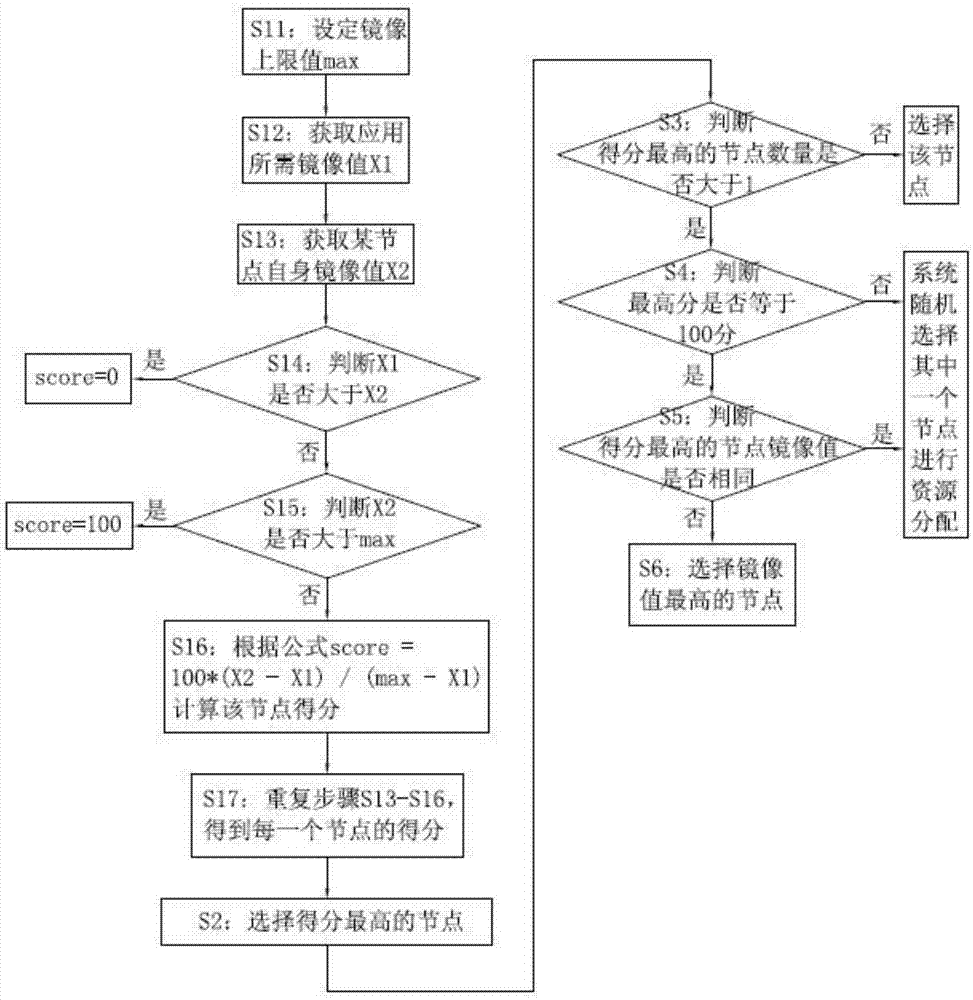Container resource scheduling method
A resource scheduling and container technology, applied in the field of cloud computing, can solve problems such as resource size, resource allocation waste, resource waste, etc., and achieve the effect of saving bandwidth and the time required for downloading images, improving efficiency, and improving operating efficiency
- Summary
- Abstract
- Description
- Claims
- Application Information
AI Technical Summary
Problems solved by technology
Method used
Image
Examples
Embodiment 1
[0041] Such as figure 1 Shown as a specific embodiment, a container resource scheduling method is provided, and the method includes the following steps:
[0042] S1: Score the nodes, the specific implementation process is:
[0043] S11: Set the upper limit of mirroring max. In practical applications, you can set max to 2G, which is 2048M;
[0044] S12: Obtain the image value X1 required by the application;
[0045] S13: Obtain a node's own mirror value X2;
[0046] S14: Judge whether X1 is greater than X2, if so, the node scores score=0; if not, go to S15;
[0047] S15: Judge whether X2 is greater than max, if so, the node score = 100; if not, go to S16;
[0048] S16: Calculate the node score according to the formula score=100*(X2-X1) / (max-X1);
[0049] S17: Repeat steps S13-S16 to get the score of each node.
[0050] S2: Select the node with the highest score.
[0051] S3: Determine whether the number of nodes with the highest score is greater than 1, if yes, go to S4, if not, select the no...
Embodiment 2
[0054] Such as figure 2 Shown as a specific embodiment, a container resource scheduling method is provided, and the method includes the following steps:
[0055] S1: Score the nodes, the specific implementation process is:
[0056] S11: Set the upper limit of mirroring max. In practical applications, you can set max to 2G, which is 2048M;
[0057] S12: Obtain the image value X1 required by the application;
[0058] S13: Obtain a node's own mirror value X2;
[0059] S14: Judge whether X1 is greater than X2, if so, the node scores score=0; if not, go to S15;
[0060] S15: Judge whether X2 is greater than max, if so, the node score = 100; if not, go to S16;
[0061] S16: Calculate the node score according to the formula score=100*(X2-X1) / (max-X1);
[0062] S17: Repeat steps S13-S16 to get the score of each node.
[0063] S2: Select the node with the highest score.
[0064] S3: Determine whether the number of nodes with the highest score is greater than 1, if yes, go to S4, if not, select the ...
Embodiment 3
[0069] On the basis of embodiment 1, the following steps are added before step S1:
[0070] S0: Determine the size of the node's own resources, and remove nodes whose own resources are less than the set value.
[0071] By setting step S0, nodes that do not meet the requirements can be removed in advance before scoring, reducing the number of nodes that need to be scored, and improving efficiency. In the actual application, an example is given, the size of the set value is set to 100M.
PUM
 Login to View More
Login to View More Abstract
Description
Claims
Application Information
 Login to View More
Login to View More - R&D
- Intellectual Property
- Life Sciences
- Materials
- Tech Scout
- Unparalleled Data Quality
- Higher Quality Content
- 60% Fewer Hallucinations
Browse by: Latest US Patents, China's latest patents, Technical Efficacy Thesaurus, Application Domain, Technology Topic, Popular Technical Reports.
© 2025 PatSnap. All rights reserved.Legal|Privacy policy|Modern Slavery Act Transparency Statement|Sitemap|About US| Contact US: help@patsnap.com


